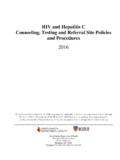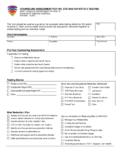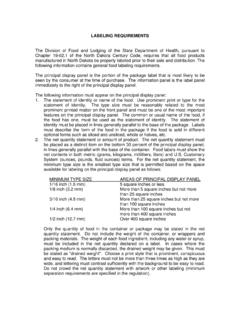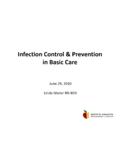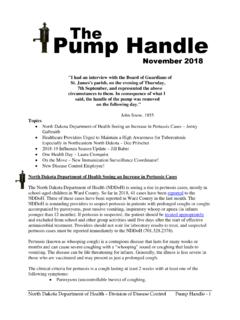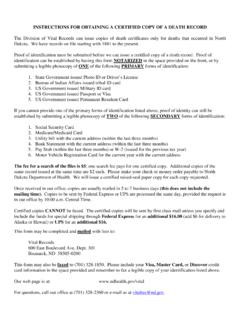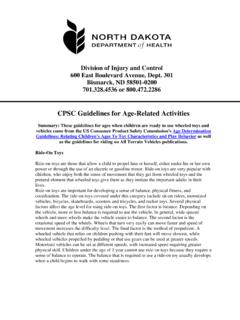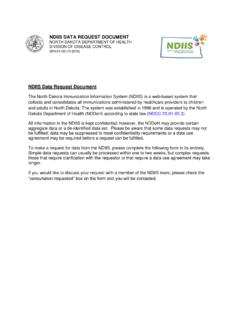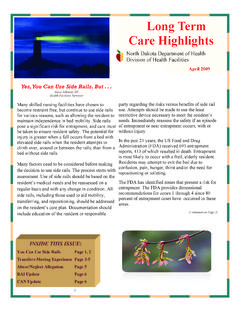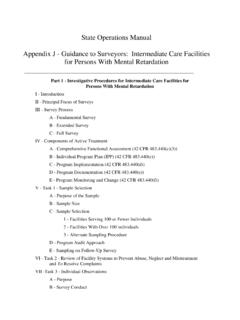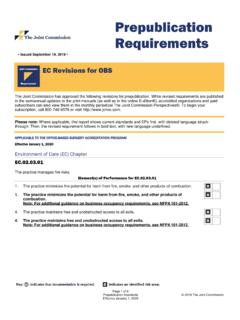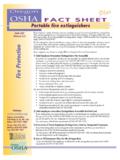Transcription of LIFE SAFETY CODE REQUIREMENTS
1 life SAFETY code REQUIREMENTS . The following are selected REQUIREMENTS of the life SAFETY code and referenced standards applicable to health care facilities. Documentation indicating compliance with these REQUIREMENTS is required at the time of the life SAFETY code survey. fire DRILLS. fire exit drills must include the transmission of a fire alarm signal and the simulation of emergency fire conditions, except that the movement of residents to safe areas or to the exterior of the building is not required. Drills must be conducted quarterly on each shift to familiarize staff with signals and emergency actions required under varied conditions. At least 12 drills shall be held every year. Drills must be held at unexpected times and under varying conditions to simulate an actual fire . When drills are conducted between 9:00 and 6:00. , a coded announcement may be used instead of audible alarms. The purpose of a fire drill is to test the efficiency, knowledge, and response of staff.
2 Its purpose is not to disturb or excite residents. Documentation of fire drills is required. Documentation shall include the date and time of the drill. fire EMERGENCY PLAN. A written plan for fire emergencies is required and must be kept up to date and used during fire drills. fire ALARM. The fire alarm system must be tested monthly. This may be done in conjunction with the fire drill. Note that activation of the fire alarm is not required during the drill on the night shift. However, the fire alarm system must still be tested each month. The fire alarm system can be tested by activating a manual pull station or smoke detector. Upon activation of the alarm, determine that smoke and fire doors close properly, the fire department notification device functions, smoke dampers close, etc. Documentation of monthly testing is required. The fire alarm system must be serviced annually. Documentation of the results of the annual service is required. SMOKE DETECTORS.
3 The sensitivity of the smoke detectors must be checked within one year after installation and every alternate year thereafter. After the second required calibration test, if sensitivity tests indicate that the detector has remained within its sensitivity range, the length of time between calibration tests can be extended up to 5 years. Detectors found to have a sensitivity test outside the listed and marked sensitivity range must be cleaned and recalibrated or replaced. Documentation of the results of the sensitivity testing is required. AUTOMATIC SPRINKLER SYSTEM. The sprinkler system must be serviced annually. Documentation of the results of the annual service is required. Also, a minimum of 6 spare sprinklers and a special sprinkler wrench for each type of sprinkler used in the facility must be kept on hand in a cabinet provided for this purpose. Note that in areas covered by the automatic sprinkler system, the tops of cubicle curtains must have a mesh with a minimum opening of.
4 There must not be any obstructions within 18 of the bottom of sprinkler heads. This would include materials placed on shelves in closets, storage rooms, etc. KITCHEN RANGE HOOD. The kitchen range hood automatic extinguishing system must be serviced every 6 months. Documentation of the results of the semiannual testing is required. PORTABLE fire EXTINGUISHERS. fire extinguishers must be subjected to maintenance at intervals of not more than one year. Documentation of the annual maintenance is required. All fire extinguishers must be checked each month to verify they are in the designated place, they have not been actuated or tampered with, and there is no damage or condition to prevent their operation. Documentation of the monthly checks is required. This may be accomplished by dating and initialing the tag attached to each extinguisher . FLOOR FINISH. All newly installed carpet in corridors and exits of nonsprinklered buildings must have a Class I interior floor finish rating.
5 Documentation of the rating and a sample of the carpet are required. FURNISHINGS. Draperies and curtains (including cubicle curtains but excluding shower curtains) and other similar furnishings and decorations must be flame resistant. Documentation of the flame resistance and a sample of the material are required. In lieu of using materials that are inherently flame resistant, we will accept the application of flame retardant coatings. These flame retardant coatings must be maintained so as to retain the effectiveness of the treatment. All manufacturer's instructions for application and retreatment must be followed. Documentation of the product used, the application procedure, and conditions under which the treatment must be reapplied are required. Where laundering will remove the flame retardant application, documentation of the dates of the application, laundering, dry cleaning, reapplication, etc. are required to verify that these materials have been re-treated.
6 Also note that live Christmas trees are not permitted unless they are fire retardant treated. Again, documentation of this treatment is necessary. EMERGENCY GENERATOR. Generators must be exercised under load at least monthly for a minimum of 30 minutes. Documentation of the monthly and annual operation is required. EXIT DISCHARGE. The exit discharge is that portion of exiting occurring from the exterior of the exit door of the facility to a point of SAFETY away from the building. Examples would be sidewalks, driveways, and other dry surfaces. The surface of this exit discharge must be asphalt or concrete to allow the movement of wheelchairs and beds when evacuation of the building is necessary. This would require that all snow be removed from these areas during winter months. At all times, these surfaces must be maintained in a dry, stable, solid condition. Lighting is required at the exterior of all exits. Lighting must be arranged so that the failure of a single bulb will not leave an area in darkness.
7 This may be accomplished by the use of a lighting fixture with two or more independent bulbs, the use of two or more independent lighting fixtures, or the use of HID fixtures with single bulbs. HID lighting is acceptable due to the long life of the bulbs. Commonly used types of these fixtures are high pressure sodium or mercury vapor. HID lighting must be equipped with a quick strike feature to allow the fixture to quickly provide lighting after a power failure. OTHER. Use of extension cords is prohibited. Restricted use of power strips is permitted. Walls and ceilings must not have unsealed penetrations. Penetrations by pipes, conduit, cable, etc. must be sealed with fire -rated material. Portable space heaters cannot be used. Wastebaskets must be of a non-combustible material or have a UL or FM label. Corridor smoke doors must be adjusted to close properly. There shall be a gap no greater than 1/8 between the two leaves. Doors opening onto corridors from rooms must close tightly in their frames and be provided with positive latching hardware.
8 These doors must be maintained in adjustment so that they close and latch. The doors must fit tightly into the door frame with no excessive gaps that will allow the passage of smoke. Doors equipped with self-closing devices cannot be propped or wedged in an open position. The use of kickdown devices or door wedges is prohibited on all doors. Corridors and exits must be maintained free and clear at all times. All equipment, carts, chairs, tables, wheelchairs, etc. not in immediate use must be removed from the corridor. Corridors and exits, including stairways, are not to be used as storage areas.
